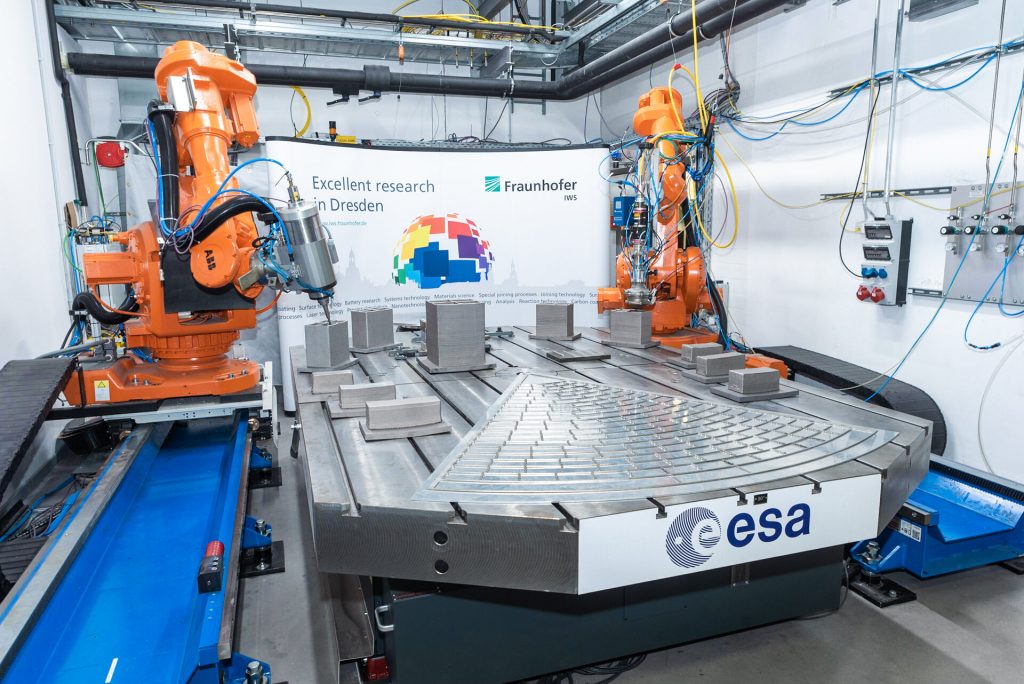Austrian industrial R&D firm RHP Technology has 3D printed a set of demonstrator parts that could form the ‘eye’ of the European Space Agency’s (ESA’s) new space telescope.
Nicknamed the Advanced Telescope for High-ENergy Astrophysics, or ‘Athena’ for short, the long-range X-ray telescope is being built to map hot cosmic gasses and black holes. Using its novel ‘Plasma Metal Deposition’ 3D printing process, RHP Technology has been able to produce six prototype parts for Athena, proving the technology’s efficacy, and potentially warranting its use within the final build.
“RHP demonstrated that large 3D parts can be printed for space applications,” said Susanne Katzler Fuchs of Brimatech, ESA Space Solutions’ technology transfer broker in Austria. “In the future, this technology can be used for applications on Earth such as industrial, aeronautics or automotive applications.”

Athena’s cosmos-mapping quest
Initially announced back in June 2014, Athena is being built as part of the ESA’s Cosmic Vision 2015–25 plan, which effectively maps-out the agency’s long-term strategic goals. Once constructed, the 12 meter-long telescope is set to feature state-of-the-art instruments, that enable it to investigate the origins, formation and evolution of black holes.
In theory, ESA scientists will be able to use Athena to observe the X-ray emissions left behind by hot cosmic materials just before they’re swallowed up by black holes, and measure the resulting distortions to determine the anomaly’s behavior. The ultra-precise telescope could also allow researchers to better understand other astronomical phenomena, such as gamma-ray bursts and the magnetic interplay between exoplanets and stars.
Rather than being deployed on terra firma, the space telescope is set to be launched onboard an Ariane 64 launch vehicle, into orbit around the ‘L2’ point of the Sun-Earth system, where it will observe up to 300 celestial points each year. Although Athena was initially scheduled for launch in 2028, this has since been pushed back to 2033, as Athena remains under construction.
“Athena provides a significant leap forward in scientific capabilities compared with previous X-ray missions,” said the ESA’s Director of Science and Robotic Exploration, Alvaro Giménez, at the project’s launch. “Its selection [for launch] ensures that Europe’s success in the field of X-ray astronomy is maintained far beyond the lifetime of our flagship observatory XMM-Newton.”

Prototyping Athena’s ‘eye’
In order to demonstrate the potential of its Plasma Metal Deposition technology, and expedite Athena’s development, RHP Technology worked with aerospace start-up accelerator ESA Space Solutions, as well as AC Aerospace and Advanced Composites and FOTEC, to produce a part-processed version of what could become Athena’s ‘eye.’
Interestingly, according to ESA engineer Laurent Pambaguian, the resulting large-format parts demonstrated sufficient mechanical properties to warrant the process’ use within the creation of Athena’s ‘optical bench’ as well. Set to be the most complex titanium 3D printed part ever produced, the intricate structure is designed to align and secure the 750 mirror modules needed to focus high-energy rays.
To function effectively, the shape of the optical bench will need to be around 3 meters in diameter, while remaining precise down to the last few tens of micrometres. However, Pambaguian now believes that Plasma Metal Deposition is more than up to the task, and says that qualifying new materials for the process, could also unlock further structural benefits in future.
“We investigated the entire process chain, including follow-up heat treatment and post-processing machining as well as 3D printing, using titanium alloy as either metal particles or wire feedstock,” concluded Pambaguian. “The results mean we are able to take the technology forward, including the investigation of alternative materials.”
3D printing an eye in the sky
While 3D printing telescopes that facilitate space exploration might sound like something out of science fiction, the technology’s precision and repeatability are fast making it science-fact. Just last May, Stratasys also 3D printed parts for the Russian and Italian Space agencies’ Mini-EUSO telescope, which is now monitoring UV emissions from aboard the ISS.
Sandia National Laboratories, meanwhile, has used a design for additive manufacturing (DfAM) approach to 3D print a functional telescope, capable of performing at the same level as those costing five times more. The lab team were able to compensate for a downgrade in lens quality, by creating an algorithm that cancels-out errors and distortions.
On a much smaller scale, Polish scientists have developed a 3D printable open-source DIY telescope called ‘Telescope Prime.’ Composed of a parabolic mirror, Raspberry Pi and additive manufactured fixtures, the telescope may not be space-age, but its design is instead optimized to make it accessible and address the needs of entry-level users.
To stay up to date with the latest 3D printing news, don’t forget to subscribe to the 3D Printing Industry newsletter or follow us on Twitter or liking our page on Facebook.
Are you looking for a job in the additive manufacturing industry? Visit 3D Printing Jobs for a selection of roles in the industry.
Featured image shows a supermassive black hole in action. Image via the ESA.



